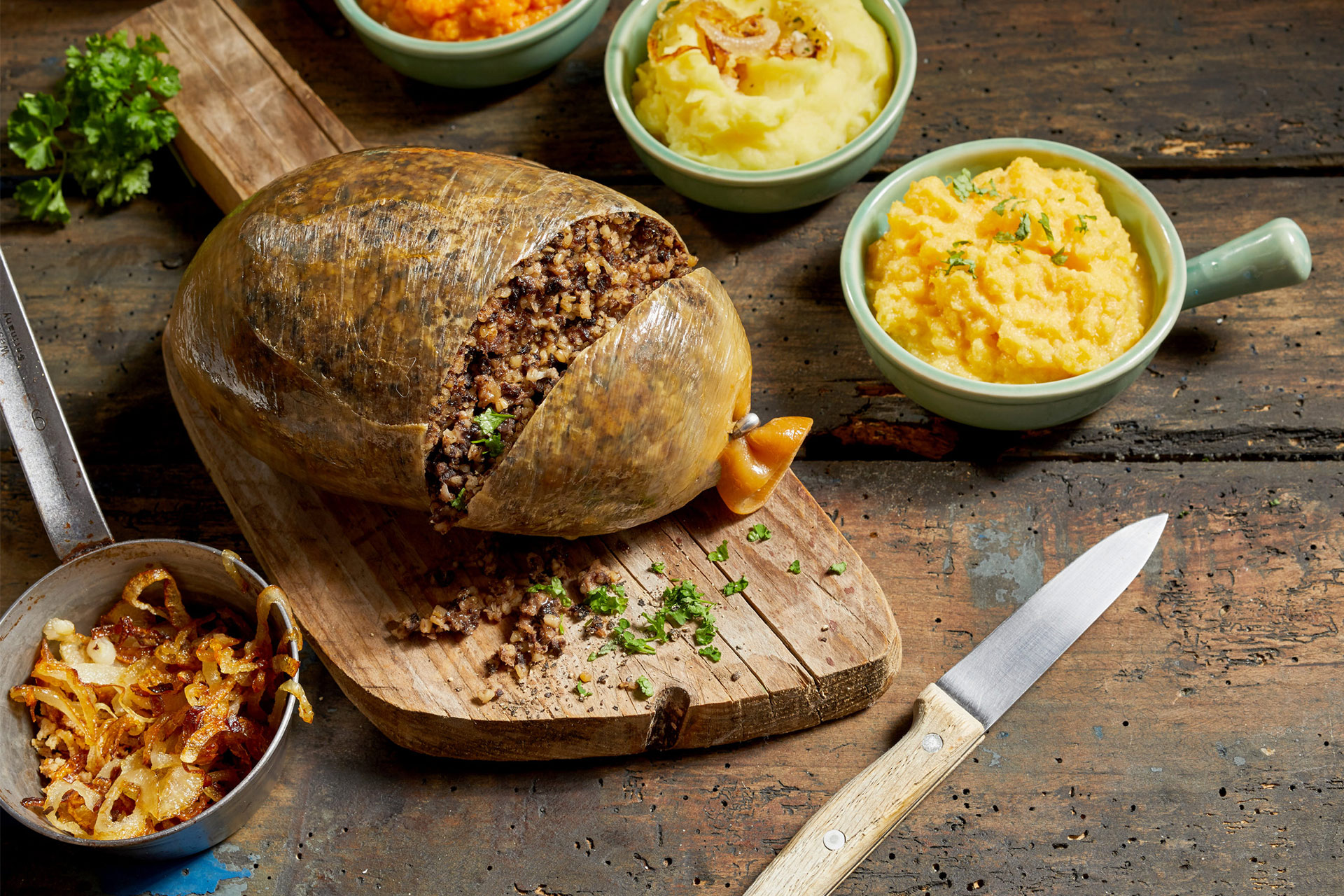Kingdom Haggis | Scotland’s National Dish And Cultural Icon
For many, the first encounter with haggis is often a mix of curiosity and apprehension. But for those who appreciate the best of Scottish cuisine, the name Kingdom Haggis is synonymous with quality.
Author:Callum FraserOct 22, 202526 Shares8.7K Views
Kingdom Haggis: A Taste Of Scotland
The word "Kingdom Haggis" conjures rich aromas, a rustic charm, and deep connections to Scotland’s proud culinary heritage. Haggis, often hailed as Scotland’s national dish, is far more than a mere meal; it embodies stories, traditions, and a fascinating history that spans centuries.
For many, it is a symbol of Scottish identity, served proudly at Burns Nightcelebrations, feasts, and family gatherings. Yet, despite its fame, haggis carries an aura of mystery, with origins that spark debate, legends that delight tourists, and recipes that have evolved.
The History And Origins Of Haggis In Scotland
Ancient Roots And Theories Behind Haggis
The origins of haggis remain a subject of lively historical discussion. While many closely associate the dish with Scotland, evidence suggests its roots may extend further back and span a wider area. Some food historians trace components of haggis back to ancient Rome, where soldiers were sustained on similar offal-filled recipes.
The concept of using animal offcuts creatively to avoid waste was a practical necessity across many cultures. The earliest known written references to haggis appear not in Scotland but in medieval England around the early 15th century.
One notable Renaissance English cookbook, The English Hus-Wife(1615), includes a recipe mixing oatmeal with animal blood and liver, closely resembling haggis. Additionally, the term “haggis” likely derives from Old Norse or Old French words meaning “to chop” or “to hack,” reflecting the preparation method.
Evolution Through Scottish History To National Symbol
Scotland embraced and refined haggis into the dish widely recognized today. By the 18th century, it was part of Scottish rural cuisine, especially in the Highlands, where local ingredients and resourcefulness shaped its form.
The great Scottish poet Robert Burns cemented haggis’s cultural role with his 1787 poem Address to a Haggis, celebrating it as the “chieftain o’ the pudding race.” This poem sparked the famous Burns Night traditionwhere haggis takes center stage. Folklore also enriches haggis’s story.
One beloved myth humorously claims haggis is a small, elusive creature native to Scottish hillsides, adapted to the terrain with legs of unequal length, pure fiction embraced as part of the dish’s playful mystique. Celebrations, legends, and family traditions have elevated haggis from simple sustenance to a national treasure.
Kingdom Haggis: A Distinctive Variety
Kingdom Haggis is a particular style of haggis that originates from the Kingdom of Fife, a historic county on Scotland's east coast. Known for its high-quality ingredients and meticulous preparation methods, Kingdom Haggis has gained a reputation for being one of the finest haggis varieties available.
It stands out due to its balanced blend of spices and the use of locally sourced ingredients, which impart a unique flavor profile that distinguishes it from other haggis varieties. The key to the exceptional taste of Kingdom Haggis lies in the selection of the finest lamb offal and the careful preparation process.
The offal is mixed with oatmeal, onions, and a blend of traditional spices, ensuring a perfect balance of flavors. The mixture is then encased in a natural casing, typically a sheep's stomach, and slow-cooked to achieve a tender, flavorful dish. The attention to detail and commitment to quality make Kingdom Haggis a must-try for anyone looking to experience authentic Scottish cuisine.
Preparing And Cooking Kingdom Haggis

How Do You Cook Haggis? - United Kingdom Explorers
Preparing Kingdom Haggis requires a bit of time and effort, but the result is well worth it. Here's a step-by-step guide to making your own Kingdom Haggis at home.
Ingredients
- 1 sheep's heart, liver, and lungs (cleaned and trimmed)
- 1 large onion, finely chopped
- 225g oatmeal
- 100g suet
- 1 teaspoon ground black pepper
- 1 teaspoon salt
- 1 teaspoon ground coriander
- 1 teaspoon ground nutmeg
- 1/2 teaspoon ground cayenne pepper
- 500ml lamb stock
- 1 sheep's stomach (cleaned and soaked overnight in cold water)
Instructions
- Prepare the Offal: Begin by boiling the sheep's heart, liver, and lungs in salted water for about 2 hours. Once cooked, finely chop the offal and set it aside.
- Toast the Oatmeal: In a dry skillet, toast the oatmeal over medium heat until golden brown. This step adds a nutty flavor to the haggis.
- Mix the Ingredients: In a large bowl, combine the chopped offal, toasted oatmeal, suet, onion, and spices. Mix well to ensure all ingredients are evenly distributed.
- Add Stock: Gradually add the lamb stock to the mixture, stirring continuously until you achieve a moist but not too wet consistency.
- Stuff the Stomach: Spoon the mixture into the sheep's stomach, leaving some room for expansion. Sew the opening closed with kitchen twine.
- Cook the Haggis: Place the stuffed stomach in a large pot of boiling water, ensuring it is fully submerged. Reduce the heat and simmer for approximately 3 hours. Check occasionally to ensure the haggis remains covered with water.
- Serve: Once cooked, carefully remove the haggis from the pot and let it rest for a few minutes. Slice and serve with traditional accompaniments such as neeps (turnips) and tatties (potatoes).
Oven Baking
For a more hands-off approach, baking is a great alternative. It’s a method many experienced cooks prefer for its reliability.
- Remove the outer packaging but leave the casing on.
- Wrap the haggis tightly in foil and place it in an ovenproof dish.
- Add about an inch of boiling water to the bottom of the dish to keep the haggis moist.
- Bake in a preheated oven at 180°C (160°C fan) for the time specified on the package. The water may need to be topped up during cooking.
- When cooked through, carefully remove it from the oven, unwrap the foil, and serve.
Related: Neil's Haggis Recipe
Kingdom Haggis And Scottish Festivals
Burns Night And Other Celebrations Featuring Haggis
Kingdom Haggis plays a prominent role in various Scottish festivals and celebrations, beyond the renowned Burns Night. It is a staple at Highland Gamesevents, where it is often served to participants and spectators alike.
These traditional Scottish sports gatherings celebrate Scottish cultureand heritage, with haggis being an essential part of the festivities. Another occasion where Kingdom Haggis shines is St. Andrew's Day, celebrated on November 30th in honor of Scotland's patron saint.
Haggis is featured in many St. Andrew's Day feasts, symbolizing national pride and culinary tradition. Whether enjoyed at a grand event or a family gathering, Kingdom Haggis embodies the spirit of Scottish celebrations.
Haggis In Contemporary Scottish Cuisine And Tourism
Today, haggis remains a key emblem of Scotland, prominently featured in restaurants ranging from traditional pubs to high-end establishments. It draws tourists keen to sample authentic Scottish flavors and learn about local customs.
Haggis is also an important export, with producers like Macsween’s leading the way in packaging and distributing the dish internationally, extending Scotland’s culinary influence abroad
The Nutritional Value Of Kingdom Haggis
While haggis might not immediately come to mind when thinking about healthy foods, it is surprisingly nutritious. The offal used in haggis is rich in essential vitamins and minerals, such as iron, zinc, and vitamin B12.
Oatmeal, a key ingredient, is a great source of dietary fiber, aiding in digestion and promoting heart health. Suet, although high in fat, provides a traditional richness and flavor that defines haggis. It's important to enjoy haggis in moderation, considering its high fat content.
Pairing it with vegetables like neeps and tatties not only complements the flavors but also adds nutritional balance to the meal. Kingdom Haggis, with its carefully selected ingredients, offers a wholesome and flavorful dish that can be part of a balanced diet when enjoyed as an occasional treat.
Modern Takes On Traditional Haggis
While the classic preparation of Kingdom Haggis remains beloved, modern chefs have experimented with creative twists on this traditional dish. Vegetarian and vegan versions of haggis have become increasingly popular, substituting the meat with lentils, beans, and various vegetables.
These alternatives retain the rich, spicy flavor of traditional haggis while catering to dietary preferences and restrictions. Additionally, haggis is now featured in various innovative dishes, such as haggis-stuffed chicken breasts, haggis burgers, and even haggis nachos.
These contemporary interpretations showcase the versatility of haggis and introduce it to new audiences. Kingdom Haggis, with its superior quality, serves as an excellent base for these modern culinary creations, allowing chefs to experiment while preserving the essence of Scottish tradition.
Pairing Kingdom Haggis With Beverages
Choosing the right beverage to accompany haggis can significantly enhance the dining experience. Traditional pairings include Scotch whisky, which complements the rich, savory flavors of haggis with its smooth, peaty notes.
A dram of whisky is often enjoyed alongside haggis during Burns Night celebrations, adding to the festive atmosphere. For those who prefer non-alcoholic options, a robust ginger ale or a tart cranberry juice can provide a refreshing contrast to the richness of haggis.
Beer enthusiasts might opt for a Scottish ale or a stout, both of which pair well with the hearty flavors of Kingdom Haggis. The key is to select a beverage that complements the spices and textures of the dish, enhancing its overall appeal.
FAQs About Kingdom Haggis
What Makes Kingdom Haggis Different From Other Haggis Varieties?
Kingdom Haggis is known for its high-quality ingredients and meticulous preparation methods. The use of locally sourced lamb offal and a balanced blend of spices gives it a distinctive flavor that sets it apart from other haggis varieties.
Can I Make A Vegetarian Version Of Kingdom Haggis?
Yes, vegetarian and vegan versions of haggis are widely available. These typically substitute meat with lentils, beans, and vegetables, while maintaining the traditional spices and flavors.
How Should I Store Leftover Haggis?
Leftover haggis should be stored in an airtight container in the refrigerator and consumed within three days. It can also be frozen for up to three months. When reheating, ensure it is piping hot throughout.
What Are The Traditional Accompaniments For Kingdom Haggis?
Traditional accompaniments for haggis include neeps (turnips) and tatties (potatoes). These vegetables are typically mashed and served alongside the haggis, providing a balanced and hearty meal.
Is Haggis Safe To Eat For People With Dietary Restrictions?
While traditional haggis contains meat and animal products, there are vegetarian and vegan versions available. Additionally, those with specific dietary concerns should check the ingredients and consult with the producer to ensure the haggis meets their needs.
Conclusion
Kingdom Haggis is a culinary gem that embodies the rich traditions and flavors of Scotland. From its historic roots to its modern interpretations, haggis remains a beloved dish that brings people together in celebration.
Whether you're enjoying it during a festive Burns Night supper or exploring creative new recipes, Kingdom Haggis offers a taste of Scotland's culinary heritage. By understanding its history, preparation, and cultural significance, you can appreciate this iconic dish and savor its unique flavors. So, embrace the spirit of Scotland and indulge in the hearty, flavorful delight that is Kingdom Haggis.
Also Check Out: Popular Dishes In Scottish Cuisine You Must Try
Jump to
Kingdom Haggis: A Taste Of Scotland
The History And Origins Of Haggis In Scotland
Kingdom Haggis: A Distinctive Variety
Preparing And Cooking Kingdom Haggis
Kingdom Haggis And Scottish Festivals
The Nutritional Value Of Kingdom Haggis
Modern Takes On Traditional Haggis
Pairing Kingdom Haggis With Beverages
FAQs About Kingdom Haggis
Conclusion

Callum Fraser
Author
Callum Fraser isn't just a writer about Scotland; he's a product of its rugged landscape and rich history. Born and raised in Perthshire, with the Highlands as his backyard, his love for the nation's stories was kindled by local storytellers and long walks through ancient glens.
This passion led him to pursue a degree in Scottish History from the University of Edinburgh. For over 15 years, Callum has dedicated himself to exploring and documenting his homeland, fusing his academic knowledge with essential, on-the-ground experience gained from charting road trips through the Cairngorms, hiking the misty Cuillins of Skye, and uncovering the secrets of traditional recipes in his family's kitchen.
As the Editor-in-Chief and Lead Author for Scotland's Enchanting Kingdom, Callum's mission is simple: to be your most trusted guide. He combines meticulous research with a storyteller's heart to help you discover the authentic magic of Scotland — from its best-kept travel secrets to its most cherished traditional recipes.
Latest Articles
Popular Articles

